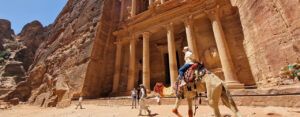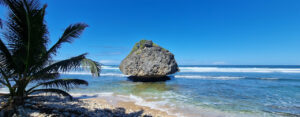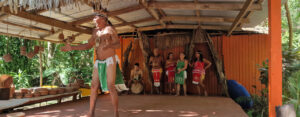
Rum and Rum-er
We arrived in Antigua in a state best described as “recently embalmed,” courtesy of the cruise ship’s rather ridiculous all-you-can-drink policy. There was a hopeful yet thoroughly unrealistic belief between us that the fresh Caribbean breeze might magically erase last night’s liquid excesses. But with a rum punch class looming ominously on our itinerary, redemption was clearly off the menu. Stumbling into the capital city of St. John’s, we were greeted by a cheerful riot of colonial architecture and Caribbean colour. In the turquoise harbour, red-roofed catamarans swayed gently, plastered with cheerful advertisements for snorkelling trips that would undoubtedly end in disaster in our current conditions. While near the pier, the remnants of British colonial rule littered the street: red phone boxes stood abandoned, a lonely Victorian post box looked as though it hadn’t handled mail since Victoria was around to personally collect it, and rusting iron railings provided a visual metaphor for the island’s complicated past.
Antigua and Barbuda’s story is both complex and compelling. Originally inhabited by the Arawak and Carib peoples, the islands were first claimed by the Spanish, briefly occupied by the French (who lasted about three months before deciding they preferred Paris), and then dominated by the British, who saw sugar plantations as the perfect business. This historical whirlwind is neatly laid out on a timeline outside the modest but surprisingly engaging National Museum, which proudly notes Antigua achieved independence as recently as 1981. Inside, the exhibits are wonderfully eclectic, featuring everything from dusty rum labels and sinister sugar-processing equipment to the rusted remains of a tiny locomotive named “Paul,” which presumably spent its career hauling sugar cane. Overhead, the Antiguan flag flaps cheerfully from a plaque offering an explanation of its colours: black representing African heritage, blue symbolising hope, and a rising golden sun promising a bright future.
We wandered uphill past shops and quiet streets to the striking white towers of St. John’s Cathedral. Built in the 1840s after two previous churches were flattened by earthquakes, the current building stands on a foundation of volcanic rock and coral. Its baroque twin towers rose defiantly skyward, framed by large iron gates that remained resolutely padlocked, presumably to discourage casual salvation outside service hours. A sturdy wall, also constructed from volcanic rock and presumably leftovers from earlier attempts, completed the scene. From this vantage point, looking beyond the clutter of angled rooftops towards the harbour below, it was easy to imagine British naval officers of centuries past squinting impatiently past the powdered wigs toward the sea, anxiously awaiting either enemy ships or a decent cup of tea.
Later, we found ourselves standing before the imposing monument of Vere Cornwall Bird—Antigua and Barbuda’s revered first Prime Minister, whose impressive name alone warrants a statue. The slightly weather-worn sculpture shows Bird draped patriotically in the national flag, his hand solemnly placed over his heart, appearing both deeply moved and mildly constipated. Bird’s career was remarkable, spanning the tricky transition from British colonial rule to full independence—an achievement that has earned him omnipresence across Antigua, from enormous roadside billboards to the country’s international airport. Appropriately, the monument stands at an actual crossroads—perhaps symbolic of a nation that spent centuries as a contested colony and is still carefully negotiating its path forward. Nearby schoolchildren, in immaculately ironed uniforms that surely required industrial-strength starch and parental dedication, strolled past selling budget SIM cards, second-hand electronics, and varieties of questionable fried meat: Antigua at its proud, chaotic, and charming best.
Our next stop was the aforementioned rum punch class—an unfortunate scheduling choice by all accounts. The venue was Quin Farara, a breezy, charmingly rustic establishment set in a former distillery. Our instructor, clearly familiar with cruise-ship casualties like ourselves, surveyed our pale complexions with professional indifference and placed ingredients before us with the seriousness of a surgeon arranging their instruments: grated nutmeg, Angostura bitters, locally revered English Harbour rum, freshly squeezed lime juice, and syrupy sugar. We muddled, measured, and stirred, following instructions as carefully as possible, occasionally pausing to stare vacantly into the middle distance. Remarkably, the resulting cocktails were genuinely excellent—refreshing, sharply citrusy, and spiced with enough nutmeg and bitters to reinvigorate even the most lifeless participant. Posters lining the walls proudly advertised every conceivable rum from around the Caribbean, ranging from backyard moonshine to internationally respected Jamaican and Puerto Rican labels. A shelf behind the bar displayed an extensive library of Antiguan rum varieties, which, after minimal persuasion (none whatsoever, in fact), found their way into our bags. We left feeling a touch more educated and marginally revived.
By late afternoon, St. John’s began to slip gently into a sunlit coma. The streets emptied, benches looked forlorn, fruit stalls closed their shutters, and open-air cafés surrendered to lethargy. It was a Caribbean afternoon devoid of bustling markets, noisy bargaining, or energetic hawking—almost suspiciously tranquil, as if the city collectively decided it was far too hot for human interaction and promptly retreated indoors. Eventually, we drifted back towards the waterfront. According to our rum instructor—whose historical insights, incidentally, grew significantly more enthusiastic after her third demonstration—the port of St. John’s has seen dramatic changes over the years. What was once a hectic hub for sugar exports, packed with wooden barrels and merchant sailors cursing over cargo, is now neatly occupied by pleasure yachts, tour boats, and a steady stream of sunburnt tourists asking where the Wi-Fi is. Behind us, restaurants gradually stirred to life, filling the air with aromas of grilled fish, seasoned rice, and the distinct smell of frying plantains. We lingered on the edge of the harbour, the setting sun turning the sea to liquid gold and casting the capital in fantastically flattering light. Finally, clutching a bottle of English Harbour rum, we headed back to the ship, hoping to try Antigua’s signature export in fresher states tomorrow.
J






















